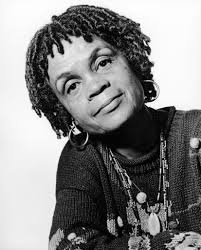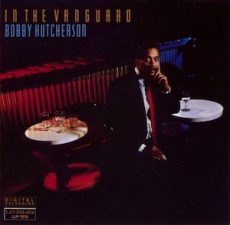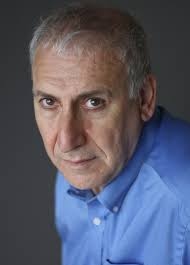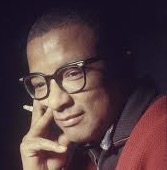
Jazz Poems
FOR OUR LADY
yehbillie if someone
had loved u like u
shud have been loved
ain’t no tellen what
kind of songs
u wud have swung
gainst this country’s wite mind
or what kind of lyrics
wud have pushed us from
our blue / nites
yeh billie
if some blk / man
had reallee
made u feel
permanentlee warm
ain’t no tellen
where the jazz of yo/songs
wud have led us.
SONIA SANCHEZ
from Jazz Poems ~ Selected and Edited by Kevin Young
More Posts: book,classic,collectible,history,jazz,library,poet

Requisites
In The Vanguard ~ Bobby Hutcherson | By Eddie Carter
This morning’s discussion arose because I’ve been listening intensely to several great vibraphonists in my library recently, leading me to an underrated live album by Bobby Hutcherson. In The Vanguard (Landmark Records LLP-1513) hit the stores in 1987 and documents excerpts of his performance over two December nights the year before at the Village Vanguard. Bobby was the first artist Orrin Keepnews signed for his new record label; this was his third release. The quartet consists of Bobby Hutcherson on the vibraphone and marimba, Kenny Barron on piano, Buster Williams on bass, and Al Foster on drums. My copy is the original U.S. Stereo album.
The opener, Little Niles by Randy Weston, is a jazz waltz. The quartet gets things off to a spirited start with their melody. Bobby opens the soloing with an infectiously swinging groove. Kenny keeps the lyricism intact with a compelling case ahead of the theme’s restatement and close. Estaté by Bruno Martino and Bruno Brighetti is up next. Williams and Hutcherson set the song in motion with a pretty introduction. Barron and Foster enter next to add sensitive warmth to the gorgeous melody. Bobby’s opening solo is beautiful; then Kenny articulates his ideas tenderly while Buster and Al hold everything together into the quartet’s graceful climax.
Well, You Needn’t by Thelonious Monk and Mike Ferro opens with Bobby’s introduction before the ensemble’s theme takes off quickly. Bobby is out of the gate first with an exhilarating reading. Kenny steps up next to play with exciting urgency. Buster and Al share a moment in the closer, preceding the foursome’s return with a quick resolution. Side Two starts with Some Day My Prince Will Come by Frank Churchill and Larry Morey. The ensemble establishes the song with a quaint melody that moves upward for Hutcherson’s opening solo. Barron turns in an exquisite performance next, and Williams provides a superbly conceived finale, one of the album’s highlights before the reprise and ending.
Witchcraft by Cy Coleman and Carolyn Leigh begins with a two-instrument dialogue between Bobby and Buster, segueing into the quartet’s lovely melody. Bobby kicks off the solos with a stream of imaginative ideas. Kenny takes the reins, gliding to the rhythm section’s buoyant beat ahead of the song’s conclusion. I Wanna Stand Over There by Bobby Hutcherson is off to the races during the quartet’s upbeat theme. Barron comes right out of the gate, bristling with energy. Hutcherson follows with a hard-driving interpretation; then Foster provides the album’s final fireworks in a short solo ahead of the theme’s restatement and climax.
In The Vanguard is a digital recording produced by Orrin Keepnews and Tom Mark, the recording engineer. George Horn mastered the album, and Danny Kopelson provided the digital transfer, editing and sequencing at Fantasy Studios. The album’s sound quality is exceptional, capturing the live energy and ambiance of the Village Vanguard. The listener becomes a part of the audience as the musicians perform with crystal-clear fidelity. Despite its high-quality performance and recording, this album is often overlooked in Bobby Hutcherson’s discography. But please don’t let that discourage you from checking out In The Vanguard by Bobby Hutcherson the next time you’re out record shopping. It’s a jazzy treat for your ears and an absolute pleasure to listen to, especially if you enjoy live jazz albums!
Postscript: Estaté is listed on the Side One label and back album cover with two composers, Bruno Martino, and Bruno Brighetti. I have no idea why this happened, but they are the same man, Bruno Martini. He was an Italian composer, pianist, singer, and songwriter. Estaté was his best-known composition; many jazz musicians and vocalists have recorded it since its first appearance in 1960. Martino’s career lasted fifty-five years; he died on June 12, 2000, at age seventy-four.
~ Bruno Brighetti, Bruno Martino – Source: Discogs.com
~ Some Day My Prince Will Come – Source: JazzStandards.com
~ Little Niles, Witchcraft – Source: Wikipedia.org
© 2024 by Edward Thomas Carter
More Posts: choice,classic,collectible,collector,history,instrumental,jazz,music,vibraphone

Jazz Poems
ART PEPPER
It’s the broken phrases, the fury inside him.
Squiggling alto saxophone playing out rickets
And jaundice, a mother who tried to kill him
In her womb with a coat hanger, a faltering
God-like father. The past is a bruised cloud
Floating over the houses like a prophecy,
The terrible foghorns off the shore at San Pedro.
Lightning without thunder. Years without playing.
Years of blowing out smoke and inhaling fire,
Junk and cold turkey, smacking up, the habit
Of cooking powder in spoons, the eyedroppers,
The spikes. Tracks on both arms. Tattoos.
The hospital cells at Fort Worth, the wire cages
In the L.A. County, the hole at San Quentin.
And always the blunt instrument of sex, the pain
Bubbling up inside him like a wound, the small
Deaths. The wind piercing the sheer skin
Of a dark lake at dawn. The streets at 5 a.m.
After a cool rain. The smoky blue clubs.
The chords of Parker, of Young, of Coltrane.
Playing solo means going on alone, improvising,
Hitting the notes, ringing the changes,
It’s clipped phrasing and dry ice in summer,
Straining against the rhythms, speeding it up,
Loping forward and looping back, finding the curl
In the wave, the mood in the air. It’s
Splintered tones and furious double timing.
It’s leaving the other instruments on stage
And blowing freedom into the night, into the faces
Of emptiness that peer along the bar, ghosts
Shallow hulls of nothingness, Hatred of God.
Hatred of white skin that never turns black.
Hatred of Patti, of Dianne, of Christine.
A daughter who grew up without him, a stranger.
Years of being strung out, years without speaking.
Pauses and intervals, silence. A fog rolling
Across the ocean, foghorns in the distance.
A lighthouse rising from the underworld.
A moon swelling in the clouds, an informer,
A twisted white mouth of light. Scars carved
And criscrossed on his chest. The memory
Of nodding out, the dazed drop-off into sleep.
And then the curious joy of surviving, joy
Of waking up in a dusky room to a gush
Of fresh notes, a tremoring sheet of sound.
Jamming again. Careening through the scales
For the creatures who haunt the night.
Bopping through the streets in a half-light
With Laurie on his arm, a witness, a believer.
The night is going to burst inside him.
The wind is going to break loose forever
From his lungs. It’s the fury of improvising,
Of going on alone. It’s the fierce clarity
Of each note coming to an end, distinct,
Glistening. The alto’s full-bodied laughter
The white grief-stricken wail.
EDWARD HIRSCH
from Jazz Poems ~ Selected and Edited by Kevin Young
More Posts: book,classic,collectible,history,jazz,library,poet

Requisites
A Night In Tunisia ~ Art Blakey and The Jazz Messengers | By Eddie Carter
This morning’s record from the library is an exceptional jazz album where the musicians complement each other behind the iconic drummer Art Blakey. A Night In Tunisia (Blue Note BLP 4049/BST 84049) is a 1961 release that is not just one of the best LPs in The Jazz Messengers discography but a historical treasure that is better experienced than described. In the spotlight with Art on this date are Lee Morgan on trumpet, Wayne Shorter on tenor sax, Bobby Timmons on piano, and Jymie Merritt on bass. The 1978 King Record Company Japanese Stereo reissue is my copy (Blue Note BST 84049 – GXK 8041).
A Night In Tunisia by Dizzy Gillespie and Frank Paparelli starts swinging with Art’s lively introduction to the quintet’s brisk melody. Wayne launches into a hard-driving interpretation, showcasing his technical prowess and emotional depth. Lee continues cooking with energetic exuberance, his trumpet work adding a vibrant layer to the tune. Jymie demonstrates his skillful command of the bass, walking with authority in a short solo. Art fuels the finale with intense emotion ahead of the theme’s vigorous restatement.
The ensemble eases to a medium melody for Sincerely Diana by Wayne Shorter, stepping aside for the saxophonist’s bluesy opening statement. Morgan carries himself well in the following reading, his trumpet work adding a soulful touch. Then, Timmons delivers a delightfully relaxed performance, his piano playing adding a smooth, jazzy feel. Blakey provides a memorable exclamation point ahead of the closing chorus, his drumming adding a dynamic energy to the piece.
So Tired by Bobby Timmons starts Side Two at a medium tempo, with a boogaloo flavor for the ensemble’s theme. Wayne gives the opening solo an unmistakable melodic charm. Lee next illustrates a splendid study in soulful improvisation; then Bobby hits an ideal groove, leading to the theme’s restatement and graceful fadeout. Yama is the first of two originals by Lee Morgan, and the quintet’s melody is a model of uncomplicated beauty. Timmons is up first and shows his soloist capabilities to fine advantage here in a gentle performance. Morgan responds with a tender, tasteful presentation next. Shorter culminates the solos with an affectionately intimate reading over the trio’s lush foundation into the song’s soothing ending.
Art’s drums kick off the album closer, Kozo’s Waltz by Lee Morgan. The complete ensemble joins in for the medium-fast theme. Wayne gets things underway with a passionate opening statement. Lee responds with an exciting interpretation; Timmons follows with a few intriguing choruses. Art puts his stamp on the closing solo with a sizzling beat before the return to the theme. Alfred Lion produced the initial session, and Rudy Van Gelder was the recording engineer, both of whom were instrumental in capturing the quintet’s energy and chemistry. This King Record Company reissue has a spectacular soundstage that transports the musicians to the sweet spot in your listening room with stunning fidelity. If you’re a hard bop fan, I happily recommend A Night In Tunisia for a place in your jazz library. It’s a gem by Art Blakey and The Jazz Messengers that no jazz enthusiast should miss on their next shopping trip!
~ A Night In Tunisia – Source: JazzStandards.com
© 2024 By Edward Thomas CarterMore Posts: choice,classic,collectible,collector,drums,history,instrumental,jazz,music

Jazz Poems
LUSH LIFE
I used to visit all the very gay places,
Those come-what-may places,
Where one relaxes on the axis of the wheel of life
To get the feel of life
From jazz and cocktails.
The girls i knew had sad and sullen gray faces,
With distingué traces
That used to be there.
You could see where
They’d been washed away
By too many through the day
Twelve o’clock tails.
Then you came along
With your siren song
To tempt me to madness.
I thought for a while
That your poignant smile
Was tinged with the sadness
Of a great love for me.
Ah, yes, I was wrong,
Again, I was wrong!
Life is lonely again,
And only last year
Ev’rything seemed so sure.
Now life is awful again,
A troughful of hearts could only be a bore.
A week in Paris will ease the bite of it.
All I care is to smile in spite of it.
I’ll forget you, I will,
While yet you are still
Burning inside my brain.
Romance is mush, stifling those who strive.
I’ll live a lush life in some small dive,
>And there I’ll be, while I rot with the rest
Of those whose lives are lonely too.
BILLY STRAYHORN
from Jazz Poems ~ Selected and Edited by Kevin Young
More Posts: book,classic,collectible,history,jazz,library,poet



